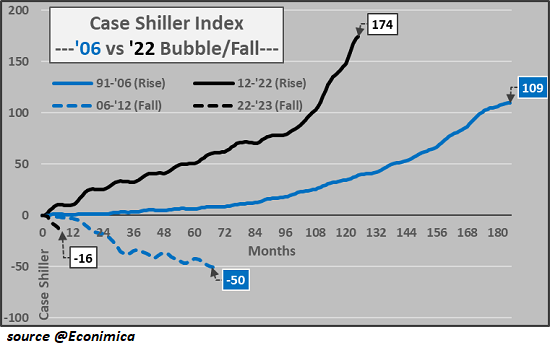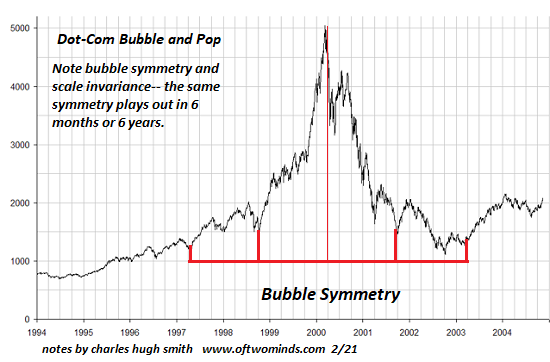As well as what occurs following? Bubble balance: assessments drop at the very same price as they climbed, decreasing back to the beginning factor over an about equal time period.
All speculative bubbles share specific characteristics: the desertion of care, the ecstasy of relatively limitless gains, the ultimate re-connect with truth (i.e. the bubble stands out) as well as bubble balance as the falls decrease mirrors the blissful climb.
At the very same time, the details beginning as well as nature of each bubble is one-of-a-kind to its period as well as condition. The real estate bubble that stood out with such damaging effects in 2007-08 was the outcome of the huge development of subprime home mortgage loaning which started as a modern objective of broadening own a home to the lower-middle course by reducing credit score criteria.
This excellent rapidly changed right into the eruptive development of whole sectors manipulating this brand-new swimming pool of subprime customers using straight-out scams: no-document car loans (also known as phony car loans), unfavorable passion home loans, interest-only home loans, and so on, all sustained by the product packaging of guaranteed-to-default home loans in mortgage-backed protections fraudulently veneered with a low-risk ranking released by recorded rankings firms.
The rock that begins the landslide does not need to be all that big. The whole subprime home mortgage industry was a fairly moderate portion of the home mortgage market as well as a small piece of the worldwide economic system, however it is the nature of bubbles to be a pyramid home of cards in which the whole bubble is based upon financial debt broadening on the allegedly strong structure of quickly climbing security: the McMansion that cost $300,000 a couple of months back has actually increased in worth as well as currently sustains a $500,000 home mortgage.
The thrilled speculator takes the “cost-free cash” $200,000 as well as purchases one more McMansion, and more, pyramiding the very first home right into a mini-empire of houses, all getting worth as the bubble increases. This virtuous comments increases real estate assessments, security as well as financial debt that is released to acquire even more houses.
After that the comments loophole turns around. Once the bubble stands out, assessments decrease, collateral lessens as well as at some point all the home loans are undersea, i.e. in need of support by security. At the very same time, revenue produced by the possessions decreases, making it tough for the proprietor to service the financial debt, which perversely, stays the like assessments drop.
This moment about, the resource of the bubble isn’t subprime customers, it’s affluent financiers as well as firms utilizing “excess cost savings” as well as simple credit score to purchase houses as well as rental apartment or condos as “secure” locations tp park their excess funding. Excess cost savings remains in quotes since the “excess” cash isn’t cost savings in itself, it’s unearned gains produced by purchasing possessions long back at reduced interest rates. As assessments skyrocketed, the affluent proprietors of funding have actually been “strained” with the job of where to park all these enormous gains.
Macro-economists reference this “excess cost savings” as an issue without discovering the truth it’s just the leading 5% which have this “issue”: as numerous have actually recorded, the huge bulk of the gains produced by the economy/assets have actually built up to the leading 5% that got possessions early in the cycle as well as utilized their abilities, links as well as funding to skim the majority of the revenue gets along with the majority of the funding recognition.
Globalization as well as financialization focused the economic situation’s gains in firms, which likewise got the “issue” of what to do with all this “excess cost savings.” One preferred option is utilize the cash to redeem shares, an “financial investment” that enhances incomes per share by lowering the variety of shares superior which accumulates to investors as well as those supervisors that have superior supply alternatives based upon the worth of shares.
Both the riches 5% as well as firms likewise had accessibility to inexpensive credit score. Adequate earnings, significant possessions– these are very eye-catching to lending institutions, therefore the most effective prices are readily available to the already-wealthy that can after that touch this credit score to acquire possessions which produce greater returns.
Realty is a popular location to park “excess funding” internationally for 3 factors:
1. As a basic guideline, it’s a steady, profitable income using rental fees, either lasting or temporary trip leasings (Airbnb).
2. Realty normally has a reduced threat account than possessions such as supplies.
3. In ages of broadening credit score, utilize as well as populace, property normally boosts in worth as supply is naturally restricted by location as well as various other variables.
The temporary leasing trend is an under-appreciated vehicle driver of the craze to acquire houses as well as apartments internationally. The leading 5% reviewed accounts of proprietors banking massive earnings from temporary leasings in preferable areas as well as in feedback they released a few of their excess capital/credit to going after the temporary rental market by purchasing residential properties view undetected.
In warm property markets, affluent customers bought residential properties to hold for funding recognition. Given that lessees are prospective resources of issues, these absentee proprietors favor not to trouble renting the level or home; they actively leave it vacant given that they do not also require a rental revenue to cover the expenditures.
The web outcome of these stress to park excess funding in property? Thousands of hundreds of vacant houses as well as apartments By siphoning these residential properties off the marketplace, the affluent car park excess funding have actually produced synthetic deficiencies in lasting leasings as well as “houses available,” raising rental fees as well as pressing assessments to the moon.
Companies have actually gotten up 10s of hundreds of homes as well as developed or gotten 10s of hundreds of rental apartment or condos to secure the low-risk returns of accumulating lease as well as funding recognition.
Keep In Mind the virtuous comments for the affluent: the extra residential properties they have as well as deflect the marketplace, the better the higher stress on rental fees as well as assessments, as well as the better their revenue as well as recognition.
In the very first graph listed below (thanks to CH @Econimica), note that the populace as well as variety of staff members 18-64 years old in the American West continued to be basically level while the variety of real estate systems enhanced by 1.3 million. As well as yet there’s allegedly an unexpected scarcity of real estate for rent/sale? Any type of deficiency isn’t the outcome of populace development, it’s the outcome of rentier-investors purchasing systems as financial investments as well as holding them off the long0-term rental/ possession markets.
There’s likewise a group part: the variety of youngsters that can manage to acquire a level or house from the absentee-rentier affluent/ company proprietors has actually lessened as rate of interest have actually climbed as well as real estate costs have actually risen. Essentially, this focus of possession in the hands of rentier affluent as well as firms has actually stripmined the marketplace of traditional house customers.
Essentially, liquidity has actually been taken out from the property market. The affluent can market to various other affluent homes, however because that’s 5% of the people at ideal, the marketplace is slim/ illiquid. As soon as marketing commences, there are couple of customers to sustain assessments. Illiquid markets are susceptible to accidents or falls decreases, a vibrant noticeable in the graph listed below of the present real estate bubble breast decrease.
Though couple of appear to state it, real estate need is flexible. Individuals return home, relocate with their grown-up kids, take boarders/ roomies, and so on. There is no regulation that claims an enhancing populace ensures a people of individuals that can manage $2,500 lease for a small level or $750,000 for a falling apart cottage.
In an economic crisis, rental fees go down. Real estate need slows as well as openings boost, pushing rental fees reduced. As soon as rental fees decline, assessments comply with, as assessments at some point reconnect with the basics of revenue produced by the possession.
As soon as costs of homes as well as apartments begin going down, proprietors can no more trust recognition. Unexpectedly, a low-risk possession obtains a various threat account: it’s declining, not getting worth.
To secure gains, the affluent rentier course as well as firms need to market. Great, however to whom? Having actually outpriced homes as well as stripmined the more youthful generations with overpriced rental fees, the affluent as well as the firms will certainly find there aren’t sufficient customers to sustain present assessments. As soon as absentee proprietors attempt to market en masse, the marketplace accidents.
Distortions at some point have effects. Concentrate riches as well as revenue in the leading 5% as well as firms, as well as offer the already-wealthy plentiful inexpensive credit score to focus possession of possessions, as well as you obtain an altered economic situation in which minority have actually outpriced the numerous as well as skimmed the majority of the revenue.
That’s entrusted to acquire misestimated possessions? Also couple of to prop up nosebleed assessments.
As well as what occurs following? Bubble balance: assessments drop at the very same price as they climbed, decreasing back to the beginning factor over an about equal time period. (see graph listed below).
18-64 Year Olds Personnel Real Estate Units

Situation Shiller Index ’06 vs Bubble-Fall

Dot-Com Bubble as well as Pop